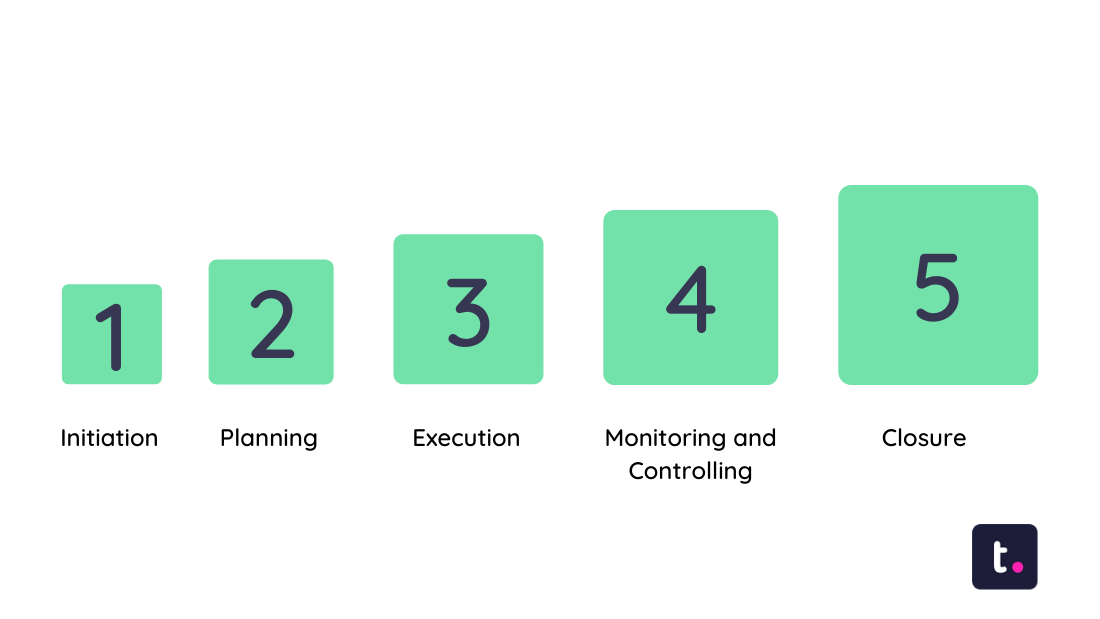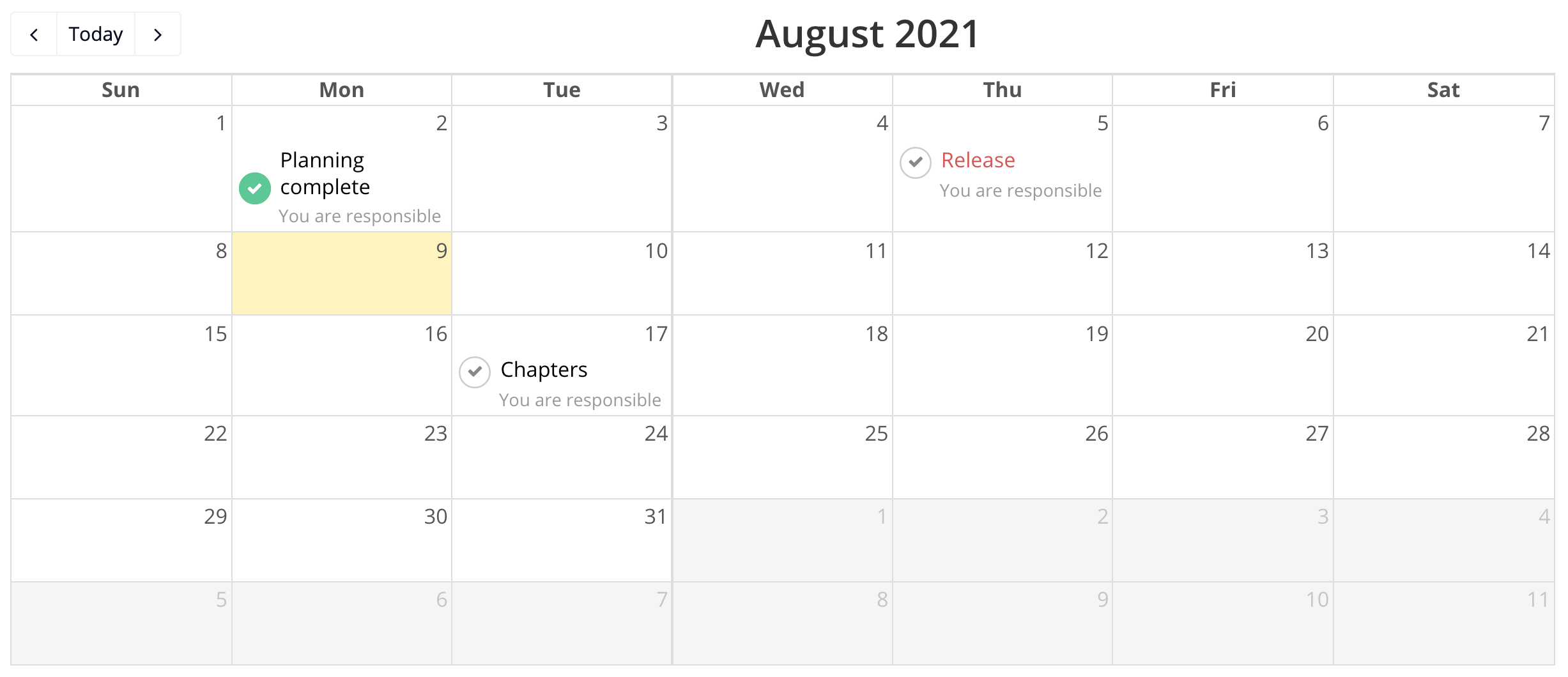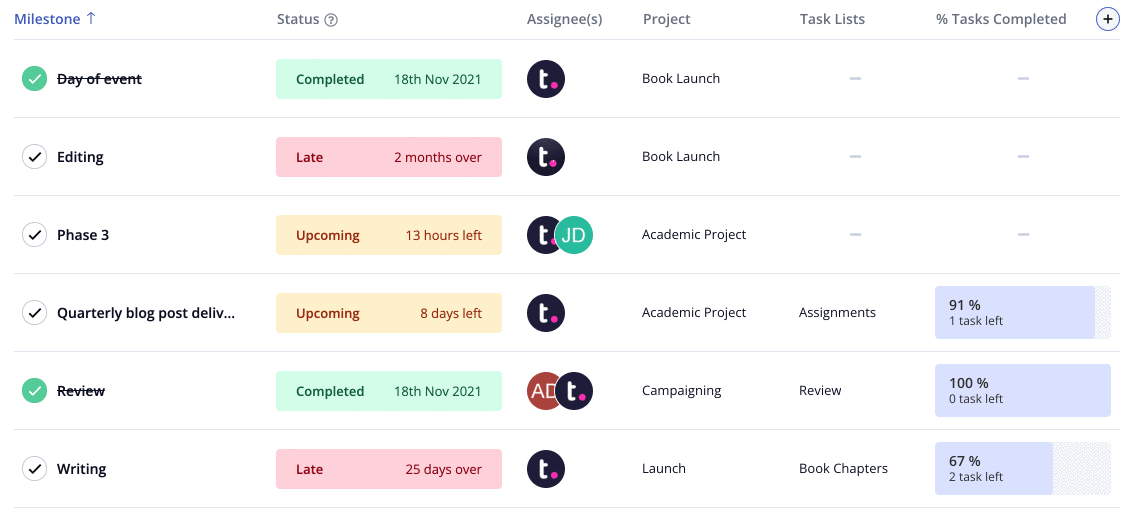What are project milestones?
Project milestones are checkpoints along the project timeline that show any significant progress toward the overall goal. Think of them as mile markers you pass driving toward your end destination.
They're the major goals you encounter en route to completing a project. And when teams reach a project milestone, stakeholders get a better sense of the progress made.
And as a project manager, stakeholder, team lead, you set the milestones within the project at key points to ensure everyone knows what is expected and by when. In fact, the Project Management Institute divides the process into five distinct phases:
Initiation
Planning
Execution
Monitoring and controlling
Closure

The five phases act as your foundational milestones. Depending on the project, you may have more milestones within each phase. This can include things like essential meetings, review periods, mid-project deliverables, or soft launches.
That said, we need to talk about what milestones are not.
Milestones shouldn’t be confused with project tasks or goals. Tasks are activities that take time and other resources. And goals determine the overall direction of the project. Milestones are simply the signposts that say, you’ve come this far.
How to set project milestones
The first step in setting project milestones is to identify the parts of a project that could represent major progress toward completion. For example, if you were working on a project to build a new website, you might identify milestones such as:
Wireframe approved
Tasks assigned to stakeholders
All design assets created
Sign off on web content, design, and code
Soft launch on X date
Remember to use milestones sparingly, as they can lose their impactfulness if they become almost as commonplace as tasks. What is a project milestone really saying, if it’s the third one that’s been ticked off this week?
This brings us to another important factor: pacing.
Ideally, your project milestones will happen at fairly regular intervals throughout the project, as this helps maintain a sense of momentum. If most of your milestones are bunched up near the start or end of a project, this could lead team members to feel complacent or overwhelmed.
Once you have identified your project milestones and decided when they should be completed, you're ready to implement them into your project. To do this efficiently, you need a project management solution that has the functionality to add, edit, and analyze project milestones.
This approach sure beats working toward milestones in parallel to your main project management process. In Teamwork.com, milestones are a bit like beefed-up tasks.
Like tasks, milestones have their own due dates and completion checkboxes, but they're set apart by features such as the functionality to associate a milestone with multiple tasks which must be done before the milestone can be marked as completed.
Project milestones help your team recalibrate
Checkpoints allow you to catch problems while they're still manageable. And they give you a chance to prepare for the demands of the next phase.
Just like planning a trip toward your destination, projects are easier to navigate when you set important signs to mark your progress. However, the road that winds through your project plan will change as you move forward and your ability to adjust is critical.
How critical?
The PMI Pulse of the Profession Report found the most significant reason for project failure is from no clear project milestones in place. To say the least, milestones are very important to project success.
But there’s no set path to follow – only your best guess, navigated by an adaptive team. Your project milestones should keep everyone in sync, so you learn and grow with the project as it matures.
Project milestones need to be easy to manage and understand
Rolling out a new project tends to be a monster of a task. Big or small, a project has many moving parts that, when unchecked, can derail even the best of plans.
Good milestone planning breaks a project up into manageable chunks, so you don’t have to handle everything at once. Good milestones also set a rhythm for the project and are not too complex for clients to understand.
Milestones should be close enough together that your team can sense the next one around the corner, but appropriately apart so they don’t become too routine. Even though it can be different for each project, there should be common points to mark your progress.
Whether you want to notify or add users, set reminders or due dates, or add detailed descriptions, creating your milestones should be an easy and flexible process. It helps when you can space out milestones and get a holistic view of them in the calendar view too!
Milestones also help identify scope creep
With regular opportunities to stop and check your status, your team can keep an eye on creep to catch it before it blows up. In fact, 52% of all projects experience some form of scope creep — and you already know what a project killer that can be.
Scope creep comes from just about anywhere: objectives get bumped around, financial requirements change (usually by growing bigger), and sometimes there’s even a shift in overall company priorities:
39% of project failures come from a change in organizational priorities
37% of projects failed after a shift in the objectives
29% of projects failed because of a lack of vision or goal
Milestones help keep these problems within view. Each milestone is a checkpoint where the team can have a look around, assess how well things are going so far, and determine what changes are needed to keep things running smoothly.
Use project milestones as a motivator
The human factor is a project manager's biggest challenge when working through a project. Everybody involved, from the client to each individual stakeholder, is a human being with human limitations.
Being human is the source of your team’s creativity, but it’s also the cause of some particularly tricky issues. A FlexJobs report found 76% of employees deal with workplace stress and 42% of those say their stress levels are significantly up.
Of course, some tasks are more taxing than others, but even the most exhilarating tasks can overheat your crew and nosedive your efficiency. Breaking the project into digestible pieces lightens this load for you and your team members.
It also creates a realistic approach to getting more work done when you can visually see the milestones within a calendar view.

Back to the trip analogy that we used earlier – there's a reason why we see mile markers, road signs, and so many other things while driving. Each one helps us visualize the path to our end destination.
Encourage team focus through milestones
It’s easier to stay focused on the task at hand when you’re not worrying about the entire journey ahead. A project is a marathon, and project milestones split that marathon into small sprints.
Between each of these sprints is a moment for everybody to reconnect and resynchronize. That’s where project milestones come in handy. They give your team a chance to start fresh with each new milestone.
Rather than grinding through task after task without any significant checkpoints, milestones break the routine and change the focus. Just make sure your clients or stakeholders can see if a milestone is upcoming, late, or completed for full visibility.

Cultivate trust and accountability with clients
If you work with clients in any capacity, understand milestones build trust through accountability that the project will be completed.
Don’t forget that the clients invest more than just trust into you – they invested cold hard cash too. They’re paying you for the promise of a valuable result and they need to know that their investment isn’t circling the drain.
In fact, some surveys show items miss their deadlines because of inaccurate project cost estimations (28%) and time estimates (25%). Don't let money be the reason for project failure.
By giving clients access to view the progress of your project milestones, they feel more in control. Getting a bird's-eye view helps clients rest assured that their investment is being put to good use.

Now, everyone can see what was planned, how it's pacing, and what needs to be done. Milestone reports that dig into what was planned vs. actual in terms of progress help keep all parties accountable and track.

Measure what was promised vs. actually delivered
The Teamwork Planned vs. Actual Milestones Report lets you view the real status of milestones across projects compared with how they were originally planned. Provide more visibility into the progress for clients or spot blockers before they become unmanageable.
Reach your project milestones with ease
The great part about project work is that there is always room to grow and improve. For quick improvements, though, look no further than your project milestones.
Milestones help you frame your projects, anchoring your efforts and keeping your project between the lines. Of course, that’s going to help you achieve greater results, even from big, complex projects.
And that’s going to make you the go-to solution for your clients or team leads.
With your project milestones in place, your team will be ready to work with a strengthened sense of where they are in a project and how well they are doing. This will help them go far and do well.


